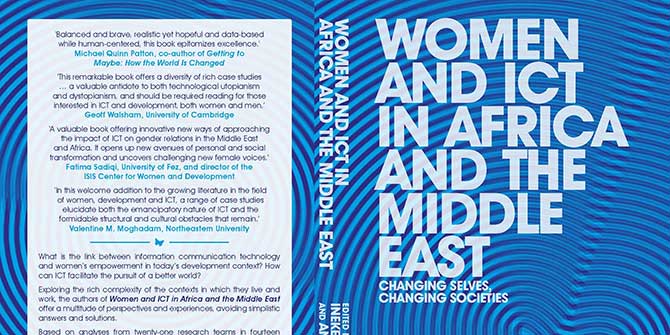LSE alumnus Samer Abdelnour examines the false causality in the gender-based violence and improved cook stoves agenda.
There is growing interest among humanitarian actors in interventions to protect vulnerable communities from gender violence, particularly displaced women and girls. Improved cookstoves are one such intervention. In fact, over the past decade hundreds of thousands of cookstoves have been delivered to women in camps with the aim of reducing the risk of sexual violence.

The idea that improved cookstoves can reduce gender violence is reaffirmed by a UK-funded white paper titled Gender-Based Violence in Humanitarian Settings: Cookstoves and Fuels – A Systematic Review Of The Evidence Base and a related Request for Applications for research recently released by the Global Alliance for Clean Cookstoves (GACC), a US advocacy organisation launched by US Presidential candidate Hillary Clinton in 2010.
Both the white paper and request for applications advocate the idea that poor and conflict-affected women can reduce their exposure to sexual violence by cooking with less fuel. The logic is as follows:
a) women and girls risk exposure to violence when searching for fuelwood for cooking;
b) improved cookstoves use less fuel for cooking;
c) this translates in fewer trips to collect fuelwood; hence,
d) using improved cookstoves reduces the risk of gender violence.
This reasoning reminds me of the oft-quoted statistics saying: correlation does not imply causation! Although women and girls may risk exposure to violence while collecting fuel, it is incorrect to assume improved cooking will reduce gender violence.
As a colleague and I painstakingly detailed in a paper titled Technologizing Humanitarian Space: Darfur Advocacy and the Rape-Stove Panacea, US-based advocacy and non-profit organisations advanced the idea that ‘stoves reduce rape’ based on racial, gendered and spatial narratives of violence, not evidence. Our critique of the ‘cookstoves-rape prevention myth’ provoked a reaction in the cookstoves community, and some stove-promoters even withdrew their claim that cookstoves reduce sexual violence. Still, some agencies remain committed to examining the link between cookstoves and violence, an example being the Safe Access to Fuel and Energy (SAFE) initiative by the World Food Programme.
Yet GACC’s white paper and request for applications does more than simply reproduce the idea that cookstoves reduce the risk of rape. They encourage biased research designs that seek to ‘prove’ causality between cookstoves and rape reduction. They do so by encouraging research that focuses on ‘non-partner’ violence and fuelwood-related violence. By design, research conducted in this way conceptually eliminates domestic and other forms of violence from view, limiting the empirical basis from which violence is studied.
Ignoring domestic violence is problematic because cookstoves are widely promoted as having an impact on domestic gender relations. Moreover, cookstove interventions are sometimes coupled with financing or entrepreneurship programmes, which can aggravate gender relations leading to increased domestic violence.
Additionally, it is well known that when camps are located in highly insecure settings, the form and risk of gender violence may be pervasive yet context-specific. There is a plethora of anecdotal evidence suggesting that displaced women and girls risk gender violence within households, inside and near camps, or while traveling long distances (which is done for many reasons, not simply to collect fuel for cooking).
Humanitarian initiatives that reduce time spent collecting fuelwood may therefore unwittingly increase exposure to violence elsewhere. This is exactly what a UNHCR-funded assessment of a fuelwood intervention at Kenya’s Dadaab camps found many years ago. Stocking households with fuel eliminated fuelwood-related violence, but did not significantly reduce overall levels of gender violence. However, some humanitarian agencies exclusively focused on fuelwood-related violence and, as a result, incorrectly claimed the intervention to be a success. The white paper cites this report but misses this relevant critique.
By emphasising non-partner and fuelwood-related violence, cookstove advocates propagate the myth that more efficient cooking reduces the risk of violence. This masks the very real risks conflict-affected women and girls face every day, not only while collecting fuelwood.
Though such a position is highly fundable, it risks harming (rather than helping) conflict-affected women and girls. In the case of Darfur, millions of dollars in aid were spent to disseminate cookstoves as a protection tool. This redirected resources away from other protection programming to cookstoves, giving some donors and development agencies the false impression that cookstoves addressed the problem of gender violence.
For over a decade, cookstove advocates have claimed that stoves reduce the risk of gender violence in humanitarian settings without conclusive supporting evidence; designing research narrowly in ways that construe evidence to ‘prove’ this claim is irresponsible.
There is an alternative approach. In the request for applications, GACC suggests they will prioritise research designs that study gender-based violence broadly, and in ways that include domestic violence and the unintended consequences of cookstove interventions. This is imperative.
Cookstove advocates must place gender and violence—not cookstoves and fuel—at the centre of research designs. Gender violence should be defined and measured comprehensively, and the impact of interventions on household gender dynamics assessed critically. This is by no means an easy task, but the totality of risks facing poor and conflict-affected women and girls compels it.
Samer Abdelnour is an Assistant Professor at the Rotterdam School of Management, Erasmus University, and recipient of a Marie Curie Fellowship on the topic of humanitarian technology. He completed his PhD at the London School of Economics and Political Science in 2015.
The views expressed in this post are those of the authors and in no way reflect those of the Africa at LSE blog or the London School of Economics and Political Science.





